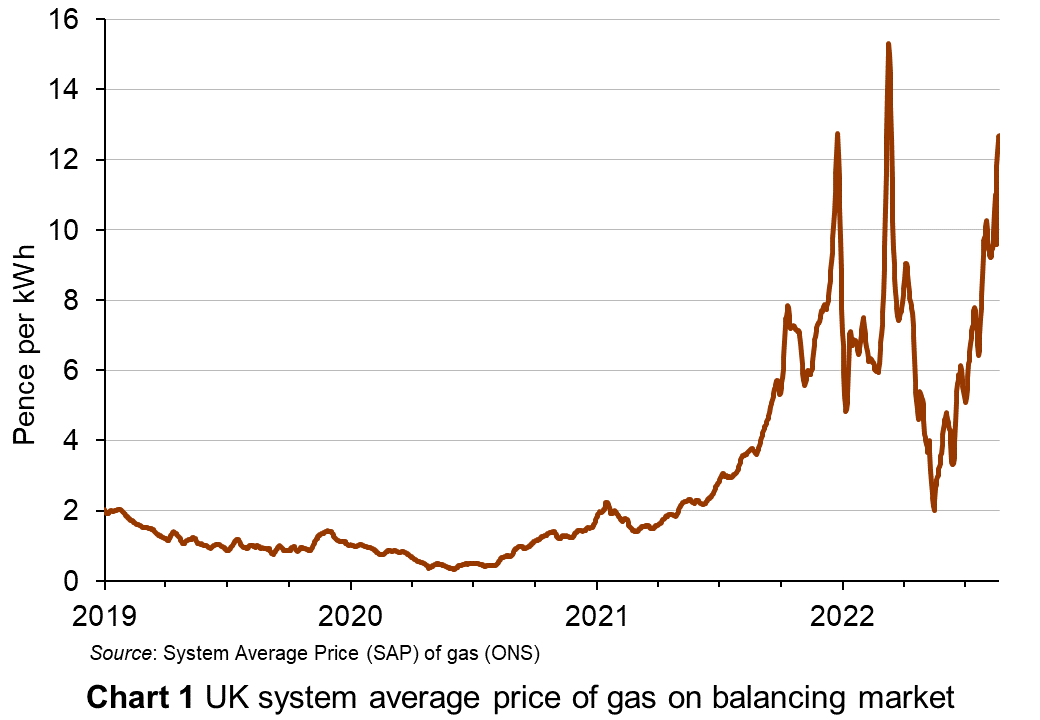 International wholesale gas prices have soared in recent months. This followed a cold winter in 2021/22 across Europe, the bounceback in demand as economies opened up after COVID and, more recently, pressure on supplies since the Russian invasion of Ukraine and the resulting restricted gas supplies from Russia. The price of gas traded on the UK wholesale market is shown in Chart 1 (click here for a PowerPoint). Analysts are forecasting that the wholesale price of gas will continue to rise for some time. The higher price of gas has had a knock-on effect on wholesale electricity prices, as gas-fired power stations are a major source of electricity generation and electricity prices.
International wholesale gas prices have soared in recent months. This followed a cold winter in 2021/22 across Europe, the bounceback in demand as economies opened up after COVID and, more recently, pressure on supplies since the Russian invasion of Ukraine and the resulting restricted gas supplies from Russia. The price of gas traded on the UK wholesale market is shown in Chart 1 (click here for a PowerPoint). Analysts are forecasting that the wholesale price of gas will continue to rise for some time. The higher price of gas has had a knock-on effect on wholesale electricity prices, as gas-fired power stations are a major source of electricity generation and electricity prices.
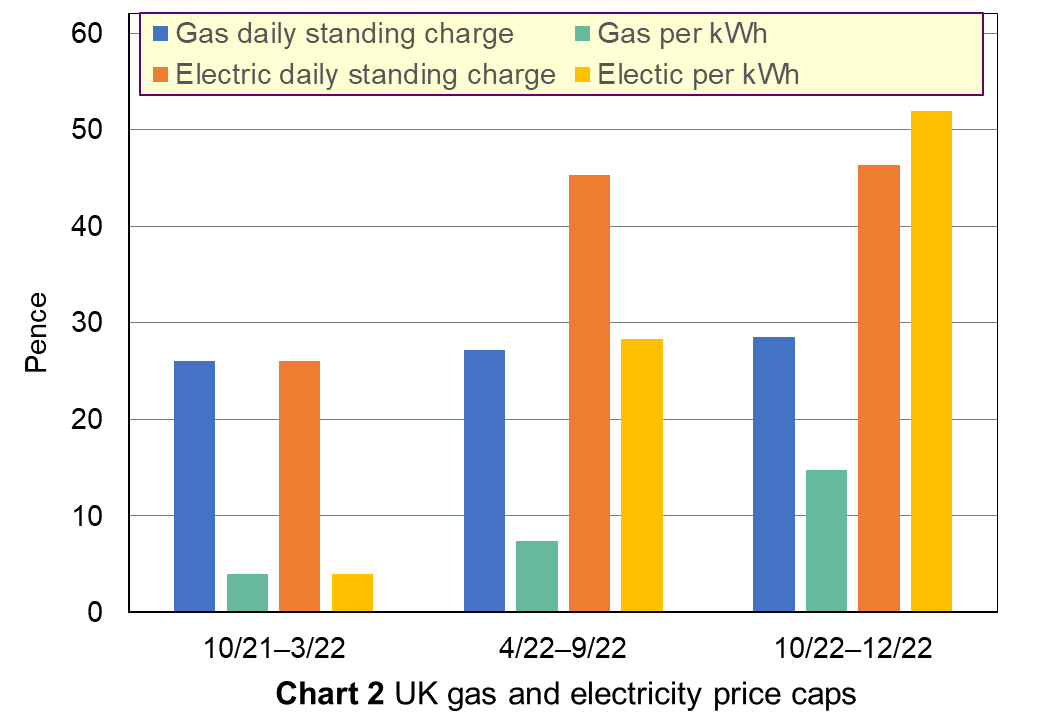 In the UK, domestic fuel prices were capped by the regulator, Ofgem. The cap reflected wholesale prices and was designed to allow electricity suppliers to make reasonable but not excessive profits. The cap was adjusted every six months, but this was been reduced to three months to reflect the rapidly changing situation. Prices are capped for both gas and electricity for both the standing charge and the rate per kilowatt hour (kWh). This is illustrated in Chart 2 (click here for a PowerPoint).
In the UK, domestic fuel prices were capped by the regulator, Ofgem. The cap reflected wholesale prices and was designed to allow electricity suppliers to make reasonable but not excessive profits. The cap was adjusted every six months, but this was been reduced to three months to reflect the rapidly changing situation. Prices are capped for both gas and electricity for both the standing charge and the rate per kilowatt hour (kWh). This is illustrated in Chart 2 (click here for a PowerPoint).
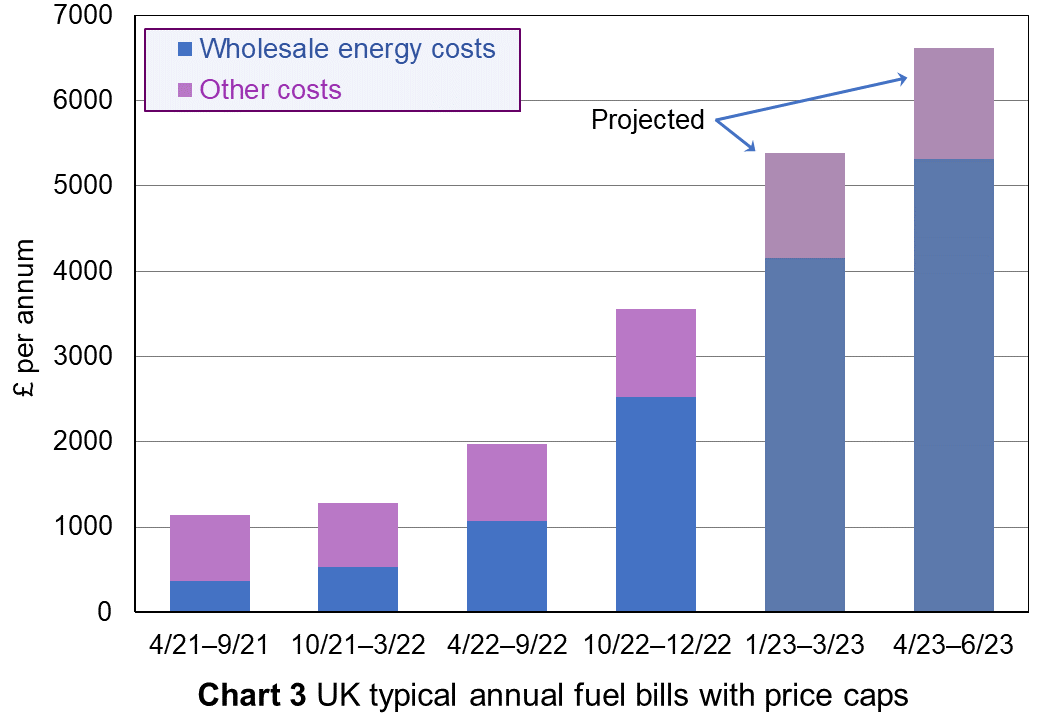 The effects of the cap were then projected in terms of a total annual bill for a typical household consuming 12 000 kWh of gas and 2900 kWh of electricity. Chart 3 shows the typical fuel bill for the last four price caps and, prior to the mini-Budget of 23 September, the projected price caps for the first and second quarters of 2023 based on forecasts at the time of wholesale prices (click here for a PowerPoint). As you can see, wholesale gas and electricity prices account for an increasing proportion of the total bill. The remaining elements in cost consist of profits (1.9% assumed), VAT (5%), operating costs, grid connection costs and green levies (around £153). The chart shows that, without government support for prices, the price cap would have risen by 80.6% in October 2022 and was projected to rise by a further 51% in January 2023 and by another 23% in March 2023. If this were to have been the case, then prices would have risen by 481% between the summer of 2021 and March 2023.
The effects of the cap were then projected in terms of a total annual bill for a typical household consuming 12 000 kWh of gas and 2900 kWh of electricity. Chart 3 shows the typical fuel bill for the last four price caps and, prior to the mini-Budget of 23 September, the projected price caps for the first and second quarters of 2023 based on forecasts at the time of wholesale prices (click here for a PowerPoint). As you can see, wholesale gas and electricity prices account for an increasing proportion of the total bill. The remaining elements in cost consist of profits (1.9% assumed), VAT (5%), operating costs, grid connection costs and green levies (around £153). The chart shows that, without government support for prices, the price cap would have risen by 80.6% in October 2022 and was projected to rise by a further 51% in January 2023 and by another 23% in March 2023. If this were to have been the case, then prices would have risen by 481% between the summer of 2021 and March 2023.
This was leading to dire warnings of extreme fuel poverty, with huge consequences for people’s health and welfare, which would put extra demands on an already stretched health service. Many small businesses would not be able to survive the extra fuel costs, which would lead to bankruptcies and increased unemployment.
Future wholesale gas prices
 Energy market analysts expect wholesale gas prices to remain high throughout 2023, with little likelihood that gas supplies from Russia will increase. Some European countries, such as Germany, have been buying large amounts of gas to fill storage facilities before winter and before prices rise further. This has added to demand.
Energy market analysts expect wholesale gas prices to remain high throughout 2023, with little likelihood that gas supplies from Russia will increase. Some European countries, such as Germany, have been buying large amounts of gas to fill storage facilities before winter and before prices rise further. This has added to demand.
The UK, however, has only limited storage facilities. Although it is not an importer of gas from Russia and so, in one sense, storage facilities are less important at the current time, wholesale gas prices reflect international demand and supply and thus gas prices in the UK will be directly affected by an overall global shortage of supply.
What would have been the response to the projected rise in gas prices? Eventually demand would fall as substitute fuels are used for electricity generation. But demand is highly inelastic. People cannot readily switch to alternative sources of heating. Most central heating is gas fired. People may reduce consumption of energy by turning down their heating or turning it off altogether, but such reductions are likely to be a much smaller percentage than the rise in price. Thus, despite some use of other fuels and despite people cutting their energy usage, people would still end up spending much more on energy.
Over the longer term, new sources of supply of gas, including liquified natural gas (LNG), may increase supply. And switching to green energy sources for electricity generation, may bring the price of electricity back down and lead to some substitution been gas and electricity in the home and businesses. Also improved home insulation and the installation of heat pumps and solar panels in homes, especially in new builds, may reduce the demand for gas. But these changes take time. Chart 4 illustrates the situation (click here for a PowerPoint).
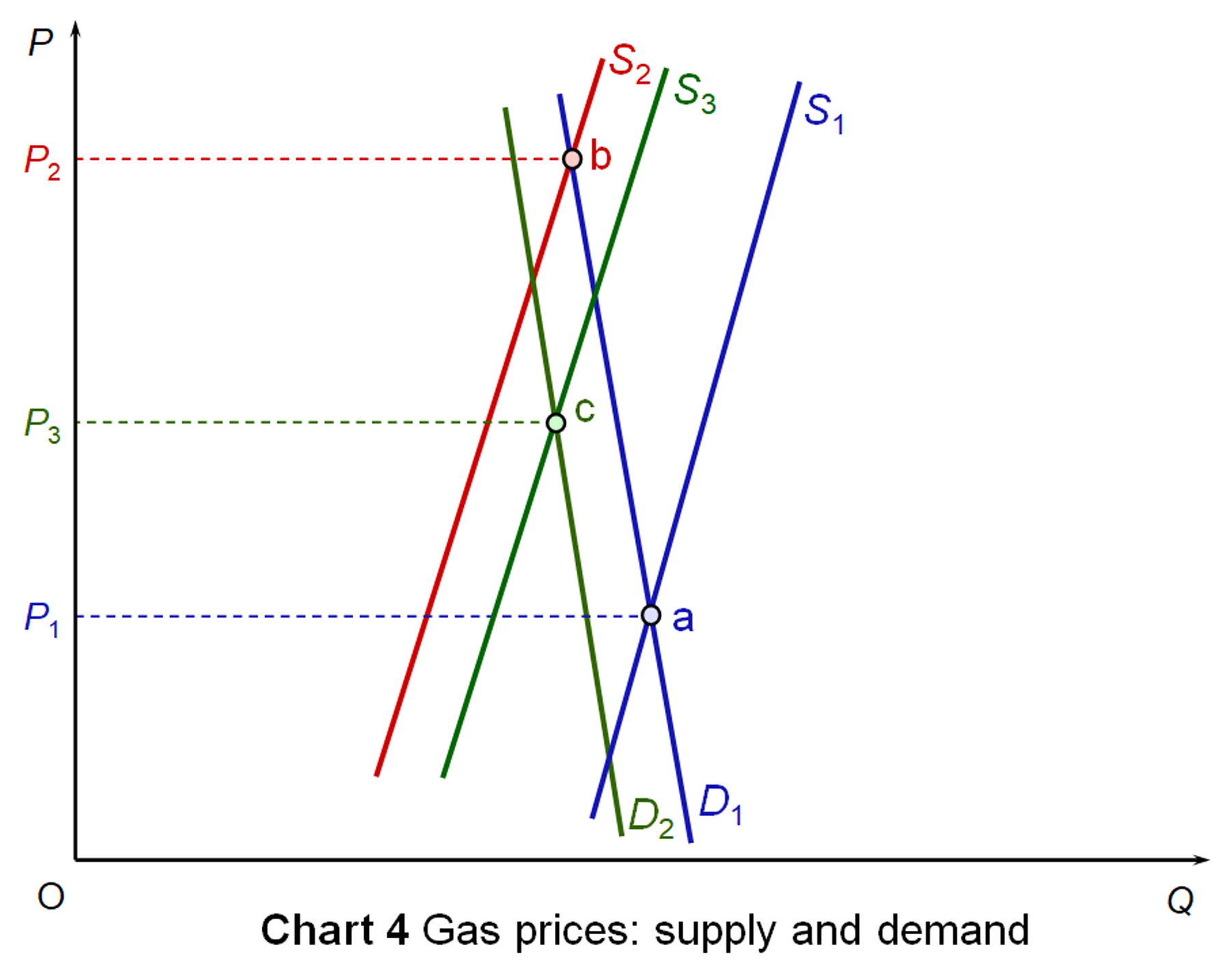 Both demand and supply are relatively inelastic. The initial demand and supply curves are D1 and S1. Equilibrium price is P1 (point a). There is now a fall in supply. Supply shifts to S2. With an inelastic demand, there is a large rise in price to P2 (point b).
Both demand and supply are relatively inelastic. The initial demand and supply curves are D1 and S1. Equilibrium price is P1 (point a). There is now a fall in supply. Supply shifts to S2. With an inelastic demand, there is a large rise in price to P2 (point b).
Over two or three years, there is a modest fall in demand (as described above) to D2 and a modest rise in supply to S3. Price falls back somewhat to P3 (point c). Over a longer period of time, these shifts would be greater and the price would fall further.
Possible policy responses
What could the government do to alleviate the problem? Consensus was that the new Conservative Prime Minister, Liz Truss, and her Chancellor, Kwasi Kwarteng, would have to take radical measures if many households were to avoid severe hardship and debt. One proposal was to reduce VAT on domestic energy from 5% to zero and to cut green levies. Although this would help, it would make only a relatively small dent in people’s rising bills.
 Another proposal was to give people cash payments to help with their bills. The more generous and widespread these payments, the more costly they would be.
Another proposal was to give people cash payments to help with their bills. The more generous and widespread these payments, the more costly they would be.
One solution here would be to impose larger windfall taxes on oil and gas producers (as opposed to retailers). Their profits have soared as oil and gas prices have soared. Such a move is generally resisted by those on the right of politics, arguing that it could discourage investment in energy production. Those on the centre and left of politics argue that the profits are the result of global factors and not because of wise business decisions by the energy producers. A windfall tax would only take away these excess profits.
The EU has agreed a tax on fossil fuel companies’ surplus profits made either this year or next. It is also introducing a levy on the excess revenues that other low-cost power producers make from higher electricity prices.
Another proposal was to freeze retail energy prices at the current or some other level. This would make it impossible for energy suppliers to cover their costs and so they would have to be subsidised. This again would be very expensive and would require substantially increased borrowing at a time when interest rates are rising, or increased taxation at a time when people’s finances are already squeezed by higher inflation. An alternative would be to cap the price North Sea producers receive. As around half of the UK’s gas consumption is from the North Sea, this would help considerably if it could be achieved, but it might be difficult to do so given that the gas is sold onto international markets.
One proposal that was gaining support from energy producers and suppliers is for the government to set up a ‘deficit fund’. Energy suppliers (retailers) would freeze energy prices for two years and take out state-backed loans from banks. These would then be paid back over time by prices being capped sufficiently high to cover costs (which, hopefully, by then would be lower) plus repayments.

Another policy response would be to decouple electricity prices from the wholesale price of gas. This is being urgently considered in the EU, and Ofgem is also consulting on such a measure. This could make wholesale electricity prices reflect the costs of the different means of generation, including wind, solar and nuclear, and would see a fall in wholesale electricity prices. At the moment, generators using these methods are making large profits.
The government’s response
On September 23, the government held a mini-Budget. One of its key elements was a capping of the unit price of energy for both households and firms. The government called this the Energy Price Guarantee. For example, those households on a variable dual-fuel, direct-debit tariff would pay no more than 34.0p/kWh for electricity and 10.3p/kWh for gas. Standing charges are capped at 46p per day for electricity and 28p per day for gas. These rates will apply for 2 years from 1/10/22 and should give an average annual household bill of £2500.
Although the government has widely referred to the ‘£2500 cap’, it is the unit price that is capped, not the annual bill. It is still the case that the more you consume, the more you will pay. As you can see from Chart 3, the average £2500 still represents an average increase per annum of just over £500 per household and is almost double the cap of £1277 a year ago. It will thus still put considerable strain on many household finances.
For businesses, prices will be capped for 6 months from 1 October at 21.1p per kWh for electricity and 7.5p per KWh for gas – considerably lower than for domestic consumers.
The government will pay subsidies to the retail energy companies to allow them to make sufficient, but not excess, profit. These subsidies are estimated to cost around £150 billion. This will be funded by borrowing, not by tax increases, with the government ruling out a windfall tax on North Sea oil and gas extracting companies. Indeed, the mini-Budget contained a number of tax reductions, including scrapping the 45% top rate of income tax, cutting the basic rate of income tax from 20% to 19% and scrapping the planned rise in corporation tax from 19% to 25%.
Articles
Data
Questions
- Why are the demand and supply of gas relatively inelastic with respect to price?
- Why are the long-run elasticities of demand and supply of gas likely to be greater than the short-run elasticities?
- Find out how wholesale electricity prices are determined. Is there a case for reforming the system and, if so, how?
- Identify ways in which people could be protected from rising energy bills.
- Assess these different methods in terms of (a) targeting help to those most in need; (b) economic efficiency.
 On March 23, Rishi Sunak, the UK’s Chancellor of the Exchequer, delivered his Spring Statement, in which he announced changes to various taxes and grants. These measures were made against the background of rising inflation and falling living standards.
On March 23, Rishi Sunak, the UK’s Chancellor of the Exchequer, delivered his Spring Statement, in which he announced changes to various taxes and grants. These measures were made against the background of rising inflation and falling living standards.
CPI inflation, currently at 6.2%, is still rising and the Office for Budget Responsibility forecasts that inflation will average 7.4% this year. The poor spend a larger proportion of their income on energy and food than the rich. With inflation rates especially high for gas, electricity and basic foodstuffs, the poor have been seen their cost of living rise by considerably more than the overall inflation rate.
According to the OBR, the higher inflation, by reducing real income and consumption, is expected to reduce the growth in real GDP this year from the previously forecast 6% to 3.8% – a much smaller bounce back from the fall in output during the early stages of the pandemic. Despite this growth in GDP, real disposable incomes will fall by an average of £488 per person this year. As the OBR states:
With inflation outpacing growth in nominal earnings and net taxes due to rise in April, real living standards are set to fall by 2.2 per cent in 2022/23 – their largest financial year fall on record – and not recover their pre-pandemic level until 2024/25.
Fiscal measures
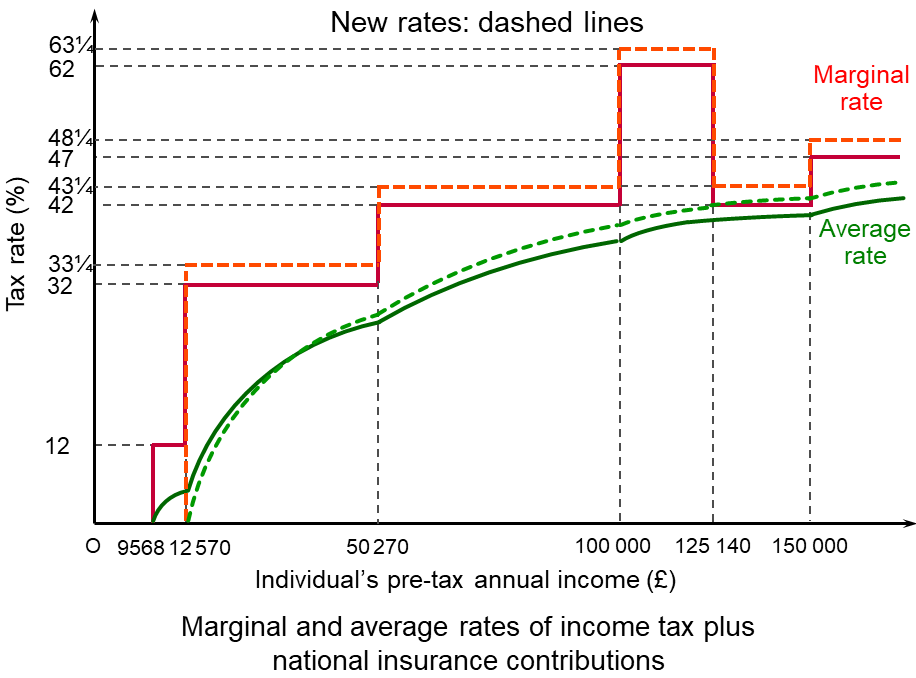 The Chancellor announced a number of measures, which, he argued, would provide relief from rises in the cost of living.
The Chancellor announced a number of measures, which, he argued, would provide relief from rises in the cost of living.
- Previously, the Chancellor had announced that national insurance (NI) would rise by 1.25 percentage points this April. In the Statement he announced that the starting point for paying NI would rise from a previously planned £9880 to £12 570 (the same as the starting point for income tax). This will more than offset the rise in the NI rate for those earning below £32 000. This makes the NI system slightly more progressive than before. (Click here for a PowerPoint of the chart.)
- A cut in fuel duty of 5p per litre. The main beneficiaries will be those who drive more and those with bigger cars – generally the better off. Those who cannot afford a car will not benefit at all, other than from lower transport costs being passed on in lower prices.
- The 5% VAT on energy-saving household measures such as solar panels, insulation and heat pumps will be reduced to zero.
- The government’s Household Support Fund will be doubled to £1bn. This provides money to local authorities to help vulnerable households with rising living costs.
- Research and development tax credits for businesses will increase and small businesses will each get another £1000 per year in the form of employment allowances, which reduce their NI payments. He announced that taxes on business investment will be further cut in the Autumn Budget.
- The main rate of income tax will be cut from 20% to 19% in two years’ time. Unlike the rise in NI, which only affects employment and self-employment income, the cut in income tax will apply to all incomes, including rental and savings income.
Fiscal drag
 The Chancellor announced that public finances are stronger than previously forecast. The rapid growth in tax receipts has reduced public-sector borrowing from £322 billion (15.0 per cent of GDP) in 2020/21 to an expected £128 billion (5.4 per cent of GDP) in 2021/22, £55 billion less than the OBR forecast in October 2021. This reflects not only the growth in the economy, but also inflation, which results in fiscal drag.
The Chancellor announced that public finances are stronger than previously forecast. The rapid growth in tax receipts has reduced public-sector borrowing from £322 billion (15.0 per cent of GDP) in 2020/21 to an expected £128 billion (5.4 per cent of GDP) in 2021/22, £55 billion less than the OBR forecast in October 2021. This reflects not only the growth in the economy, but also inflation, which results in fiscal drag.
Fiscal drag is where rises in nominal incomes mean that the average rate of income tax rises. As tax thresholds for 2022/23 are frozen at 2021/22 levels, a greater proportion of incomes will be taxed at higher rates and tax-free allowances will account for a smaller proportion of incomes. The higher the rate of increase in nominal incomes, the greater fiscal drag becomes. The higher average rate of tax drags on real incomes and spending. On the other hand, the extra tax revenue reduces government borrowing and gives the government more room for extra spending or tax cuts.
The growth in poverty
 With incomes of the poor not keeping pace with inflation, many people are facing real hardship. While the Spring Statement will provide a small degree of support to the poor through cuts in fuel duty and the rise in the NI threshold, the measures are poorly targeted. Rather than cutting fuel duty by 5p, a move that is regressive, removing or reducing the 5% VAT on gas and electricity would have been a progressive move.
With incomes of the poor not keeping pace with inflation, many people are facing real hardship. While the Spring Statement will provide a small degree of support to the poor through cuts in fuel duty and the rise in the NI threshold, the measures are poorly targeted. Rather than cutting fuel duty by 5p, a move that is regressive, removing or reducing the 5% VAT on gas and electricity would have been a progressive move.
Benefits, such as Universal Credit and the State Pension, are uprated each April in line with inflation the previous September. When inflation is rising, this means that benefits will go up by less than the current rate of inflation. This April, benefits will rise by last September’s annual inflation rate of 3.1% – considerably below the current inflation rate of 6.2% and the forecast rate for this year of 7.4%. This will push many benefit recipients deeper into poverty.
One measure rejected by Rishi Sunak is to impose a temporary windfall tax on oil companies, which have profited from the higher global oil prices. Such taxes are used in Norway and are currently being considered by the EU. Tax revenues from such a windfall tax could be used to fund benefit increases or tax reductions elsewhere and these measures could be targeted on the poor.
Articles
- Overview of the March 2022 Economic and fiscal outlook
Office for Budget Responsibility (23/3/22)
- Spring Statement: Key points at a glance
BBC News (23/3/22)
- Spring statement 2022: key points at a glance
The Guardian, Richard Partington and Jessica Elgot (23/3/22)
- People face biggest drop in living standards since 1956
BBC News (23/3/22)
- Spring Statement: Rishi Sunak accused of not doing enough for poorest households
BBC News (24/3/22)
- Chancellor provides minimal help to households on cost of living crisis
Financial Times, Chris Giles (23/3/22)
- Britain’s poorest left to bear brunt of squeeze on cost of living
Financial Times, Delphine Strauss (23/3/22)
- Spring statement: How does Rishi Sunak’s national insurance change affect you?
Sky News, Daniel Dunford and Ganesh Rao (24/3/22)
- Spring Statement 2022 – An initial response from IFS researchers
Institute for Fiscal Studies Press Release, Stuart Adam, Carl Emmerson, Paul Johnson, Helen Miller, Isabel Stockton, Tom Waters and Ben Zaranko (23/3/22)
- Chancellor prioritises his tax cutting credentials over low-and-middle income households with £2 in every £3 of new support going to the top half
Resolution Foundation press release (23/3/22)
- Richest handed £480 boost in Spring Statement, say researchers
Politics.co.uk (23/3/22)
- UK’s most vulnerable face crunch as Rishi Sunak helps better-off
The Guardian, Larry Elliott and Heather Stewart (23/3/22)
- Rishi Sunak tackled over failure to help poorest families
The Guardian, Richard Partington and Aubrey Allegretti (24/3/22)
- A Spring Statement for White Wealth Drivers
Byline Times, Stan Norris (23/3/22)
- Rishi Sunak’s Fiscal Drag Race
Evening Standard, Jack Kessler (23/3/22)
- Rishi Sunak fails to address the hit to living standards
Financial Times, Martin Wolf (23/3/22)
- Why Rishi Sunak refused a windfall tax on oil and gas companies
The New Statesman, Philippa Nuttall (23/3/22)
OBR data and analysis
Questions
- Are the changes made to national insurance by the Chancellor progressive or regressive? Could they have been made more progressive and, if so, how?
- What are the arguments for and against cutting income tax from 20% to 19% in two years’ time rather than reversing the current increases in national insurance at that point?
- What will determine how rapidly (if at all) public-sector borrowing decreases over the next few years?
- What are automatic fiscal stabilisers? How does their effect vary with the rate of inflation?
- Examine the public finances of another country. Are the issues similar to those in the UK? Recommend fiscal policy measures for your chosen country and provide a justification.
 As we saw in Part 1, households are seeing a rise in the cost of living, which is set to accelerate. Inflation in the year to January 2022, as measured by the Consumer Prices Index (CPI), was 5.5%, the highest rate for over 30 years, and it is expected to reach more than 7 per cent by April. This has put great pressure on household budgets, with wage rises for most people being below the rate of price inflation. The poor especially have been hard hit, with many struggling to meet soaring energy, food and transport prices and higher rents.
As we saw in Part 1, households are seeing a rise in the cost of living, which is set to accelerate. Inflation in the year to January 2022, as measured by the Consumer Prices Index (CPI), was 5.5%, the highest rate for over 30 years, and it is expected to reach more than 7 per cent by April. This has put great pressure on household budgets, with wage rises for most people being below the rate of price inflation. The poor especially have been hard hit, with many struggling to meet soaring energy, food and transport prices and higher rents.
In Part 2 we look at the UK government’s response to the situation, a similar response to that in many other countries.
Effects on government finances
 The Chancellor, Rishi Sunak, has stated that the government understands the pressures families are facing with the cost of living. However, rising interest rates mean that it will cost the Treasury considerably more to service the UK’s national debt of more than £2tn.
The Chancellor, Rishi Sunak, has stated that the government understands the pressures families are facing with the cost of living. However, rising interest rates mean that it will cost the Treasury considerably more to service the UK’s national debt of more than £2tn.
Interest payments on index-linked debt are calculated using an alternative measure of inflation, the retail prices index (RPI), which is running at 7.8%, considerably higher than anticipated in last October’s Budget. It is now projected that central government spending on debt interest this financial year will come in at around £69bn, some £11bn higher than the £58bn forecast in the October 2021 Budget and £27bn above the £42bn forecast in the March 2021 Budget.
In addition, it is expected that the latest rise in CPI will increase the chances of the Bank of England raising interest rates and thereby further increasing the costs of servicing national debt. If this is the outcome when its Monetary Policy Committee meets next month, then it would be the third successive time interest rates have been raised.
There is also concern that this, in addition to the direct effects of higher costs, will push more firms towards insolvency. It is argued that if government wanted to prevent this, it would need to cut business taxes in order to boost investment and productivity and to allow businesses to provide annual wage rises that are affordable.
Monetary policy
 The Bank of England’s traditional response to rising inflation is to raise interest rates, which it has done this twice in the past few months. This means that people who have borrowed money could see their monthly payments go up, especially on mortgages tied to Bank Rate.
The Bank of England’s traditional response to rising inflation is to raise interest rates, which it has done this twice in the past few months. This means that people who have borrowed money could see their monthly payments go up, especially on mortgages tied to Bank Rate.
An aim of this policy is to make borrowing more expensive resulting in people spending less. As a result, they will buy fewer things, and prices will stop rising as fast. However, when inflation is caused by external forces, this might have a limited effect on prices and would put a further squeeze on household budgets.
Fiscal policy
Alternatively, the government might choose to cut taxes for consumers on items whose prices are rising quickly. It is taking some measures to reduce the impact of energy price rises. For example, the Treasury has announced that it would provide millions of households with up to £350 to help with their rising energy bills and in April the lowest-paid will see the National Living Wage rise by 6.6%, which is higher than the current inflation rate.
The chief economist of the British Chambers of Commerce has said that tightening monetary policy too quickly risks undermining confidence and the wider recovery, arguing that more needs to be done to limit the unprecedented rise in costs facing businesses, including financial support for those struggling with soaring energy bills and delaying April’s national insurance rise.
Conclusion
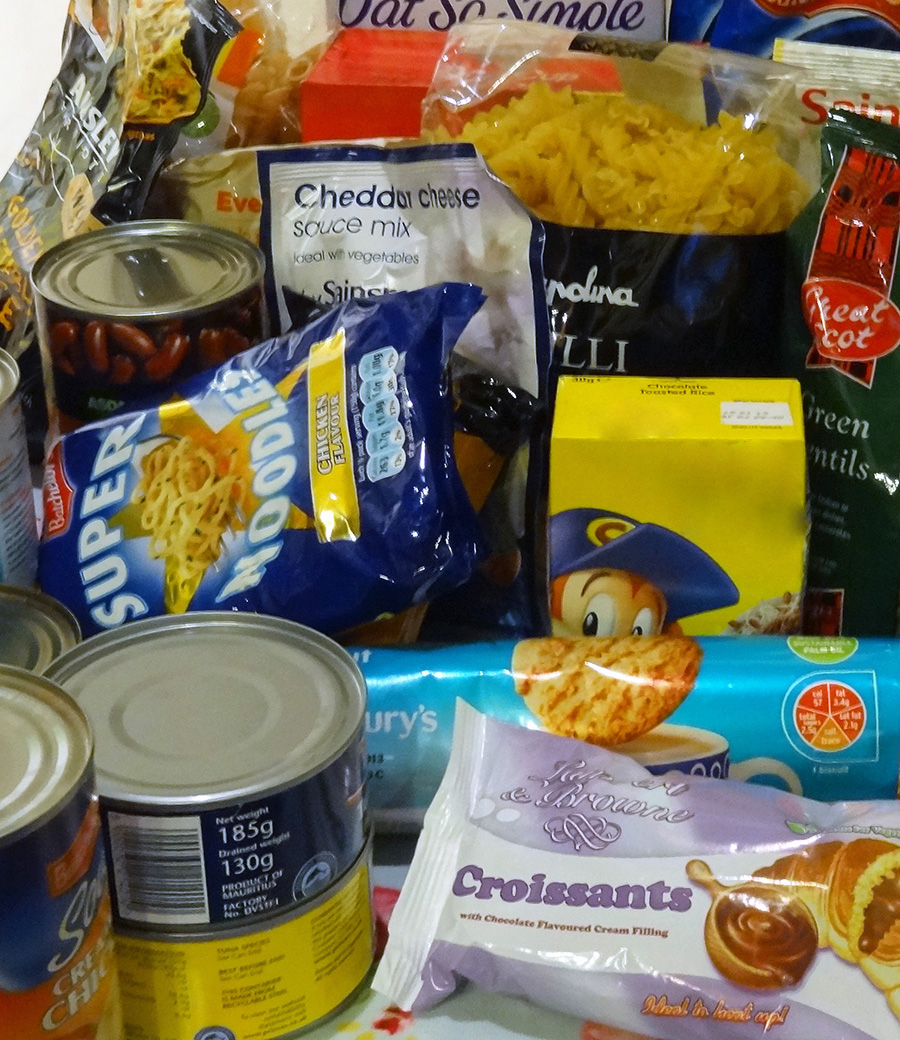 Rising inflation affects all our living standards. It a global issue with causes beyond government control.
Rising inflation affects all our living standards. It a global issue with causes beyond government control.
Rising prices together with planned tax increases mean that real average take-home pay is likely to fall over the coming year. The extra energy costs and tax rises will force families to make savings elsewhere, meaning business revenues may fall, and the economic recovery could be negatively impacted.
However, it is those on low incomes that tend to find it hardest to cope with the rising cost of living. Those impacted the most will be faced with difficult decisions over the coming months as they try to cope with falling real incomes. With food price inflation expected to rise further, a likely rise in interest rates and a further increase in the energy price cap in October, these tough decisions are set to get harder for poorest households in the economy.
Articles
See articles in Part 1
Podcast
Questions
These questions are based on the podcast.
- What elements are there in household energy prices? Which element has gone up most?
- What are the arguments for and against the government delaying the rise in the rate of national insurance by 1.25 percentage points?
- What can be done to help people on modest earnings who earn just too much to receive benefits?
- Are government loans to help people with higher bills a good idea?
- What are the advantages and disadvantages of removing VAT on domestic energy?
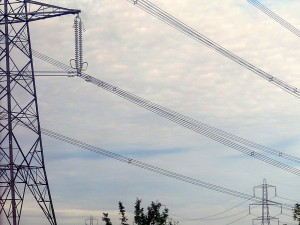 Since Labour’s historic pledge to eliminate child poverty in a generation, poverty data has been at the forefront of political debates. The recession has created unemployment and has moved more people below the poverty line, at the same time as causing rising inequality
Since Labour’s historic pledge to eliminate child poverty in a generation, poverty data has been at the forefront of political debates. The recession has created unemployment and has moved more people below the poverty line, at the same time as causing rising inequality
The causes of poverty are diverse and a recent government commissioned report has drawn attention to just one of the key factors that is pushing more families into poverty – energy bills.
Fuel poverty has become more of a concern with the cost of household bills rising and this has led to calls for more money to be invested in cutting energy bills. Fuel poverty has been redefined by Professor John Hills, the author of the report, to focus on those households with a low income and also with relatively high energy bills.
Fuel poverty is undoubtedly concerning from a moral point of view – indeed, knowing that some families are unable to afford to heat their homes causes disutility for others. However, there are also wider economic implications. If families are unable to provide heating, this may adversely affect their children’s ability to learn and complete their homework, thus negatively affecting their productivity today and arguable causing further problems in their future. While this may have little effect today, the cumulative effect on economic productivity could be substantial in the long run. Inefficiency for the macroeconomy is therefore a problem, as a child’s productive potential will not be fully realized. Furthermore, there are also health concerns, as the government notes – fuel poverty is linked to 2,700 deaths per year. Again, this creates a blight on society, but it also poses economic problems, not least due to the strain on the NHS.
Fuel poverty has long been identified as a problem that needs addressing and as the Secretary of State for Energy and Climate Change said:
‘Fuel poverty is a serious national problem and this government remains committed to doing all it can to tackle it and make sure that the help available reaches those who need it most.’
Action is already taking place to insulate the poorest homes, as a means of cutting their energy bills and the government’s ‘Warm Homes Discount’ aims to provide help to the lowest income households in paying their bills. However, there are concerns that more households will move into fuel poverty, as this new definition doesn’t include those slightly wealthier households who still have high bills or the poorer households with relatively low bills. With the economy still in a vulnerable state, the latest data showing further rises in unemployment and household bills becoming increasingly expensive, the issue of fuel poverty is unlikely to disappear any time soon. The following articles consider this issue.
Fuel poverty seen for 3 million households by 2016 Reuters (16/3/12)
Fuel poverty to rise to 8.5m, report warns (including video) BBC News, Damian Kahya (15/3/12)
Nine million will live in ‘fuel poverty’ in the next four years Independent, Simon Read (16/3/12)
Fuel poverty to rise sharply Telegraph, James Hall (16/3/12)
Call for urgent action on fuel poverty Financial Times, Sarah Neville (15/3/12)
Fuel poverty worse than estimated The Press Association (15/3/12)
3 million fuel-poor households by 2016, report claims Guardian, Mark King and Zammy Fairhurst (15/3/12)
Questions
- What are the causes of poverty?
- How has the definition of fuel poverty changed? Is the change a good one? Think about the equity and efficiency of such a change.
- The BBC News article says that government measures to alleviate fuel poverty could be regressive. What is meant by this and why could this be the case?
- What are the economic consequences of fuel poverty?
- We can estimate poverty by looking at the poverty headcount or the poverty gap. What is the difference between these two measures? Which one is a more accurate measure of poverty?
- Are there any other actions that you think would be effective in alleviating fuel poverty? Would they be cost effective?
- Why does Age UK fear ‘the current proposals to improve energy efficiency through the Green Deal and energy obligation schemes are a woefully inadequate response to one of the most serious issues facing our country today’?
The snow the UK has seen over the past two winters created massive disruption, but that is only one reason for hoping for a milder winter to come. With the cold weather, the UK economy faced threats of gas shortages, as households turned on their heating. However, despite the freezing temperatures, many households were forced to turn off their heating regularly, due to the excessive bills they would face. This trend is expected to be even more prevalent if the 2011/12 winter is as cold, as fuel tariffs are predicted to rise. The Bank of England has said that gas and electricity prices could rise this year by 15% and 10% respectively. British Gas’s Parent company, Centrica said:
“In the UK the forward wholesale prices of gas and power for delivery in winter 2011/12 are currently around 25% higher than prices last winter, with end-user prices yet to reflect this higher wholesale market price environment.”
These predictions might see the average UK household paying an extra £148 over the next year. Although these are only estimates, we are still very likely to see many households being forced to turn off their heating. One thing which therefore is certain: a warmer winter would be much appreciated!
Articles
Switch energy tariff to help beat bill rises Guardian, Miles Brignall (14/5/11)
Quarter of households predicted to turn off heating BBC News, Brian Milligan (14/5/11)
Power bills set to soar by 50% in four years Scotsman (14/5/11)
Domestic fuel bills poised to rise by up to £200 Financial Times, Elaine Moore (13/5/11)
Data
Energy price statistics Department of Energy & Climate Change
Energy statistics publications Department of Energy & Climate Change
Questions
- Which factors have contributed to rising energy prices? Illustrate these changes on a demand and supply diagram.
- To what extent do these higher prices contribute to rising inflation?
- What impact might these price rises have on (a) poverty and (b) real income distribution in the UK?
- Why are energy prices currently being investigated by Ofgem? What powers does the regulator have and what actions could be taken?
 International wholesale gas prices have soared in recent months. This followed a cold winter in 2021/22 across Europe, the bounceback in demand as economies opened up after COVID and, more recently, pressure on supplies since the Russian invasion of Ukraine and the resulting restricted gas supplies from Russia. The price of gas traded on the UK wholesale market is shown in Chart 1 (click here for a PowerPoint). Analysts are forecasting that the wholesale price of gas will continue to rise for some time. The higher price of gas has had a knock-on effect on wholesale electricity prices, as gas-fired power stations are a major source of electricity generation and electricity prices.
International wholesale gas prices have soared in recent months. This followed a cold winter in 2021/22 across Europe, the bounceback in demand as economies opened up after COVID and, more recently, pressure on supplies since the Russian invasion of Ukraine and the resulting restricted gas supplies from Russia. The price of gas traded on the UK wholesale market is shown in Chart 1 (click here for a PowerPoint). Analysts are forecasting that the wholesale price of gas will continue to rise for some time. The higher price of gas has had a knock-on effect on wholesale electricity prices, as gas-fired power stations are a major source of electricity generation and electricity prices.  In the UK, domestic fuel prices were capped by the regulator, Ofgem. The cap reflected wholesale prices and was designed to allow electricity suppliers to make reasonable but not excessive profits. The cap was adjusted every six months, but this was been reduced to three months to reflect the rapidly changing situation. Prices are capped for both gas and electricity for both the standing charge and the rate per kilowatt hour (kWh). This is illustrated in Chart 2 (click here for a PowerPoint).
In the UK, domestic fuel prices were capped by the regulator, Ofgem. The cap reflected wholesale prices and was designed to allow electricity suppliers to make reasonable but not excessive profits. The cap was adjusted every six months, but this was been reduced to three months to reflect the rapidly changing situation. Prices are capped for both gas and electricity for both the standing charge and the rate per kilowatt hour (kWh). This is illustrated in Chart 2 (click here for a PowerPoint). The effects of the cap were then projected in terms of a total annual bill for a typical household consuming 12 000 kWh of gas and 2900 kWh of electricity. Chart 3 shows the typical fuel bill for the last four price caps and, prior to the mini-Budget of 23 September, the projected price caps for the first and second quarters of 2023 based on forecasts at the time of wholesale prices (click here for a PowerPoint). As you can see, wholesale gas and electricity prices account for an increasing proportion of the total bill. The remaining elements in cost consist of profits (1.9% assumed), VAT (5%), operating costs, grid connection costs and green levies (around £153). The chart shows that, without government support for prices, the price cap would have risen by 80.6% in October 2022 and was projected to rise by a further 51% in January 2023 and by another 23% in March 2023. If this were to have been the case, then prices would have risen by 481% between the summer of 2021 and March 2023.
The effects of the cap were then projected in terms of a total annual bill for a typical household consuming 12 000 kWh of gas and 2900 kWh of electricity. Chart 3 shows the typical fuel bill for the last four price caps and, prior to the mini-Budget of 23 September, the projected price caps for the first and second quarters of 2023 based on forecasts at the time of wholesale prices (click here for a PowerPoint). As you can see, wholesale gas and electricity prices account for an increasing proportion of the total bill. The remaining elements in cost consist of profits (1.9% assumed), VAT (5%), operating costs, grid connection costs and green levies (around £153). The chart shows that, without government support for prices, the price cap would have risen by 80.6% in October 2022 and was projected to rise by a further 51% in January 2023 and by another 23% in March 2023. If this were to have been the case, then prices would have risen by 481% between the summer of 2021 and March 2023.  Energy market analysts expect wholesale gas prices to remain high throughout 2023, with little likelihood that gas supplies from Russia will increase. Some European countries, such as Germany, have been buying large amounts of gas to fill storage facilities before winter and before prices rise further. This has added to demand.
Energy market analysts expect wholesale gas prices to remain high throughout 2023, with little likelihood that gas supplies from Russia will increase. Some European countries, such as Germany, have been buying large amounts of gas to fill storage facilities before winter and before prices rise further. This has added to demand.  Both demand and supply are relatively inelastic. The initial demand and supply curves are D1 and S1. Equilibrium price is P1 (point a). There is now a fall in supply. Supply shifts to S2. With an inelastic demand, there is a large rise in price to P2 (point b).
Both demand and supply are relatively inelastic. The initial demand and supply curves are D1 and S1. Equilibrium price is P1 (point a). There is now a fall in supply. Supply shifts to S2. With an inelastic demand, there is a large rise in price to P2 (point b).  Another proposal was to give people cash payments to help with their bills. The more generous and widespread these payments, the more costly they would be.
Another proposal was to give people cash payments to help with their bills. The more generous and widespread these payments, the more costly they would be.
 On March 23, Rishi Sunak, the UK’s Chancellor of the Exchequer, delivered his Spring Statement, in which he announced changes to various taxes and grants. These measures were made against the background of rising inflation and falling living standards.
On March 23, Rishi Sunak, the UK’s Chancellor of the Exchequer, delivered his Spring Statement, in which he announced changes to various taxes and grants. These measures were made against the background of rising inflation and falling living standards.  The Chancellor announced a number of measures, which, he argued, would provide relief from rises in the cost of living.
The Chancellor announced a number of measures, which, he argued, would provide relief from rises in the cost of living. The Chancellor announced that public finances are stronger than previously forecast. The rapid growth in tax receipts has reduced public-sector borrowing from £322 billion (15.0 per cent of GDP) in 2020/21 to an expected £128 billion (5.4 per cent of GDP) in 2021/22, £55 billion less than the OBR forecast in October 2021. This reflects not only the growth in the economy, but also inflation, which results in fiscal drag.
The Chancellor announced that public finances are stronger than previously forecast. The rapid growth in tax receipts has reduced public-sector borrowing from £322 billion (15.0 per cent of GDP) in 2020/21 to an expected £128 billion (5.4 per cent of GDP) in 2021/22, £55 billion less than the OBR forecast in October 2021. This reflects not only the growth in the economy, but also inflation, which results in fiscal drag. With incomes of the poor not keeping pace with inflation, many people are facing real hardship. While the Spring Statement will provide a small degree of support to the poor through cuts in fuel duty and the rise in the NI threshold, the measures are poorly targeted. Rather than cutting fuel duty by 5p, a move that is regressive, removing or reducing the 5% VAT on gas and electricity would have been a progressive move.
With incomes of the poor not keeping pace with inflation, many people are facing real hardship. While the Spring Statement will provide a small degree of support to the poor through cuts in fuel duty and the rise in the NI threshold, the measures are poorly targeted. Rather than cutting fuel duty by 5p, a move that is regressive, removing or reducing the 5% VAT on gas and electricity would have been a progressive move. As we saw in Part 1, households are seeing a rise in the cost of living, which is set to accelerate. Inflation in the year to January 2022, as measured by the Consumer Prices Index (CPI), was 5.5%, the highest rate for over 30 years, and it is expected to reach more than 7 per cent by April. This has put great pressure on household budgets, with wage rises for most people being below the rate of price inflation. The poor especially have been hard hit, with many struggling to meet soaring energy, food and transport prices and higher rents.
As we saw in Part 1, households are seeing a rise in the cost of living, which is set to accelerate. Inflation in the year to January 2022, as measured by the Consumer Prices Index (CPI), was 5.5%, the highest rate for over 30 years, and it is expected to reach more than 7 per cent by April. This has put great pressure on household budgets, with wage rises for most people being below the rate of price inflation. The poor especially have been hard hit, with many struggling to meet soaring energy, food and transport prices and higher rents. The Chancellor, Rishi Sunak, has stated that the government understands the pressures families are facing with the cost of living. However, rising interest rates mean that it will cost the Treasury considerably more to service the UK’s national debt of more than £2tn.
The Chancellor, Rishi Sunak, has stated that the government understands the pressures families are facing with the cost of living. However, rising interest rates mean that it will cost the Treasury considerably more to service the UK’s national debt of more than £2tn. The Bank of England’s traditional response to rising inflation is to raise interest rates, which it has done this twice in the past few months. This means that people who have borrowed money could see their monthly payments go up, especially on mortgages tied to Bank Rate.
The Bank of England’s traditional response to rising inflation is to raise interest rates, which it has done this twice in the past few months. This means that people who have borrowed money could see their monthly payments go up, especially on mortgages tied to Bank Rate. Rising inflation affects all our living standards. It a global issue with causes beyond government control.
Rising inflation affects all our living standards. It a global issue with causes beyond government control. 
